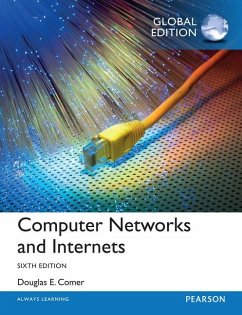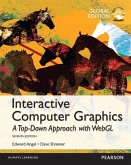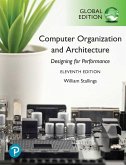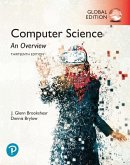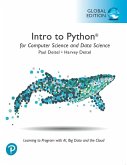Appropriate for all introductory-to-intermediate courses in computer networking, the Internet, or Internet applications; students need no background in networking, operating systems, or advanced mathematics.
Leading networking authority Douglas Comer presents a wide-ranging, self-contained tour of the concepts, principles, and technologies that enable today’s Internet to support applications ranging from web browsing to telephony and multimedia. Comer begins by illuminating the applications and facilities offered by today’s Internet. Next, he systematically introduces the underlying network technologies and protocols that make them possible. With these concepts and technologies established, he introduces several of the most important contemporary issues faced by network implementers and managers, including quality of service, Internet telephony, multimedia, network security, and network management. Comer has carefully designed this book to support both top-down and bottom-up teaching approaches. Students need no background in operating systems, and no sophisticated math: Comer relies throughout on figures, drawings, examples, and analogies, not mathematical proofs.
Teaching and Learning Experience
This program will provide a better teaching and learning experience—for you and your students.
Broad Coverage of Key Concepts and Principles, Presented in a Technology-independent Fashion: Comer focuses on imparting knowledge that students will need regardless of which technologies emerge or become obsolete.
Flexible Organization that Supports both Top-down and Bottom-up Teaching Approaches: Chapters may be sequenced to accommodate a wide variety of course needs and preferences.
An Accessible Presentation that Resonates with Students: Comer relies throughout on figures, drawings, examples, and analogies, not mathematical proofs.
Keep Your Course Current: Content is refreshed to provide the most up-to-date information on new technologies for your course.
Features + Benefits
Broad Coverage of Key Concepts and Principles, Presented in a Technology-independent Fashion
Drawing on more than 30 years’ experience at the leading edge of networking research and implementation, Comer focuses on imparting knowledge that students will need regardless of which technologies emerge or become obsolete.
Every chapter includes hands-on exercises and projects that offer opportunities for students to test their knowledge and gain confidence in their abilities.
Flexible Organization that Supports both Top-down and Bottom-up Teaching Approaches
The text is organized into five parts. Chapters may be sequenced in multiple orders to accommodate a wide variety of instructor/student/course needs and preferences.
This text combines the best of top-down and bottom-up approaches. When presented in order, the book exposes students to applications and allows them to write network programs early, while delivering all material in logical order so a reader understands how each new technology builds on lower layer technologies.
An Accessible Presentation that Resonates with Students
No sophisticated mathematics is required—instead of formal mathematical proofs, Comer presents highly accessible examples, figures, drawings, and analogies.
The text answers the basic question: how do computer networks and Internets operate? It provides a comprehensive, self-contained tour through all of networking that describes applications, Internet protocols, network technologies, such as LANs and WANs, and low-level details, such as data transmission and wiring. It shows how protocols use the underlying hardware and how applications use the protocol stack to provide functionality for users.
Keep Your Course Current
In response to suggestions from readers and recent changes in networking, the new edition has been completely revised and updated. The significant changes include:
NEW! Updates throughout each chapter
NEW! Additional figures to enhance explanations
NEW! Integration of IPv4 and IPv6 in all chapters
NEW! Improved coverage of MPLS and tunneling
NEW! New chapter on Software Defined Networking and OpenFlow
NEW! New chapter on the Internet of Things and Zigbee
Preface xxiii
PART I Introduction And Internet Applications
Chapter 1 Introduction And Overview 1
1.1 Growth Of Computer Networking 1
1.2 Why Networking Seems Complex 2
1.3 The Five Key Aspects Of Networking 2
1.4 Public And Private Parts Of The Internet 6
1.5 Networks, Interoperability, And Standards 8
1.6 Protocol Suites And Layering Models 9
1.7 How Data Passes Through Layers 11
1.8 Headers And Layers 12
1.9 ISO And The OSI Seven Layer Reference Model 13
1.10 Remainder Of The Text 14
1.11 Summary 14
Chapter 2 Internet Trends 17
2.1 Introduction 17
2.2 Resource Sharing 17
2.3 Growth Of The Internet 18
2.4 From Resource Sharing To Communication 21
2.5 From Text To Multimedia 21
2.6 Recent Trends 22
2.7 From Individual Computers To Cloud Computing 23
2.8 Summary 24
Chapter 3 Internet Applications And Network Programming 27
3.1 Introduction 27
3.2 Two Basic Internet Communication Paradigms 28
3.3 Connection-Oriented Communication 29
3.4 The Client-Server Model Of Interaction 30
3.5 Characteristics Of Clients And Servers 31
3.6 Server Programs And Server-Class Computers 31
3.7 Requests, Responses, And Direction Of Data Flow 32
3.8 Multiple Clients And Multiple Servers 32
3.9 Server Identification And Demultiplexing 33
3.10 Concurrent Servers 34
3.11 Circular Dependencies Among Servers 35
3.12 Peer-To-Peer Interactions 35
3.13 Network Programming And The Socket API 36
3.14 Sockets, Descriptors, And Network I/O 36
3.15 Parameters And The Socket API 37
3.16 Socket Calls In A Client And Server 38
3.17 Socket Functions Used By Both Client And Server 38
3.18 The Connect Function Used Only By A Client 40
3.19 Socket Functions Used Only By A Server 40
3.20 Socket Functions Used With The Message Paradigm 43
3.21 Other Socket Functions 44
3.22 Sockets, Threads, And Inheritance 45
3.23 Summary 45
Chapter 4 Traditional Internet Applications 49
4.1 Introduction 49
4.2 Application-Layer Protocols 49
4.3 Representation And Transfer 50
4.4 Web Protocols 51
4.5 Document Representation With HTML 52
4.6 Uniform Resource Locators And Hyperlinks 54
4.7 Web Document Transfer With HTTP 55
4.8 Caching In Browsers 57
4.9 Browser Architecture 59
4.10 File Transfer Protocol (FTP) 59
4.11 FTP Communication Paradigm 60
4.12 Electronic Mail 63
4.13 The Simple Mail Transfer Protocol (SMTP) 64
4.14 ISPs, Mail Servers, And Mail Access 66
4.15 Mail Access Protocols (POP, IMAP) 67
4.16 Email Representation Standards (RFC2822, MIME) 67
4.17 Domain Name System (DNS) 69
4.18 Domain Names That Begin With A Service Name 71
4.19 The DNS Hierarchy And Server Model 72
4.20 Name Resolution 72
4.21 Caching In DNS Servers 74
4.22 Types Of DNS Entries 75
4.23 Aliases And CNAME Resource Records 76
4.24 Abbreviations And The DNS 76
4.25 Internationalized Domain Names 77
4.26 Extensible Representations (XML) 78
4.27 Summary 79
PART II Data Communication Basics
Chapter 5 Overview Of Data Communications 85
5.1 Introduction 85
5.2 The Essence Of Data Communications 86
5.3 Motivation And Scope Of The Subject 87
5.4 The Conceptual Pieces Of A Communications System 87
5.5 The Subtopics Of Data Communications 90
5.6 Summary 91
Chapter 6 Information Sources And Signals 93
6.1 Introduction 93
6.2 Information Sources 93
6.3 Analog And Digital Signals 94
6.4 Periodic And Aperiodic Signals 94
6.5 Sine Waves And Signal Characteristics 95
6.6 Composite Signals 97
6.7 The Importance Of Composite Signals And Sine Functions 97
6.8 Time And Frequency Domain Representations 98
6.9 Bandwidth Of An Analog Signal 99
6.10 Digital Signals And Signal Levels 100
6.11 Baud And Bits Per Second 101
6.12 Converting A Digital Signal To Analog 102
6.13 The Bandwidth Of A Digital Signal 103
6.14 Synchronization And Agreement About Signals 103
6.15 Line Coding 104
6.16 Manchester Encoding Used In Computer Networks 106
6.17 Converting An Analog Signal To Digital 107
6.18 The Nyquist Theorem And Sampling Rate 108
6.19 Nyquist Theorem And Telephone System Transmission 108
6.20 Nonlinear Encoding 109
6.21 Encoding And Data Compression 109
6.22 Summary 110
Chapter 7 Transmission Media 113
7.1 Introduction 113
7.2 Guided And Unguided Transmission 113
7.3 A Taxonomy By Forms Of Energy 114
7.4 Background Radiation And Electrical Noise 115
7.5 Twisted Pair Copper Wiring 115
7.6 Shielding: Coaxial Cable And Shielded Twisted Pair 117
7.7 Categories Of Twisted Pair Cable 118
7.8 Media Using Light Energy And Optical Fibers 119
7.9 Types Of Fiber And Light Transmission 120
7.10 Optical Fiber Compared To Copper Wiring 121
7.11 Infrared Communication Technologies 122
7.12 Point-To-Point Laser Communication 122
7.13 Electromagnetic (Radio) Communication 123
7.14 Signal Propagation 124
7.15 Types Of Satellites 125
7.16 Geostationary Earth Orbit (GEO) Satellites 126
7.17 GEO Coverage Of The Earth 127
7.18 Low Earth Orbit (LEO) Satellites And Clusters 128
7.19 Tradeoffs Among Media Types 128
7.20 Measuring Transmission Media 129
7.21 The Effect Of Noise On Communication 129
7.22 The Significance Of Channel Capacity 130
7.23 Summary 131
Chapter 8 Reliability And Channel Coding 135
8.1 Introduction 135
8.2 The Three Main Sources Of Transmission Errors 135
8.3 Effect Of Transmission Errors On Data 136
8.4 Two Strategies For Handling Channel Errors 137
8.5 Block And Convolutional Error Codes 138
8.6 An Example Block Error Code: Single Parity Checking 139
8.7 The Mathematics Of Block Error Codes And (n,k) Notation 140
8.8 Hamming Distance: A Measure Of A Code’s Strength 140
8.9 The Hamming Distance Among Strings In A Codebook 141
8.10 The Tradeoff Between Error Detection And Overhead 142
8.11 Error Correction With Row And Column (RAC) Parity 142
8.12 The 16-Bit Checksum Used In The Internet 144
8.13 Cyclic Redundancy Codes (CRCs) 145
8.14 An Efficient Hardware Implementation Of CRC 148
8.15 Automatic Repeat Request (ARQ) Mechanisms 148
8.16 Summary 149
Chapter 9 Transmission Modes 153
9.1 Introduction 153
9.2 A Taxonomy Of Transmission Modes 153
9.3 Parallel Transmission 154
9.4 Serial Transmission 155
9.5 T
Appropriate for all introductory-to-intermediate courses in computer networking, the Internet, or Internet applications; students need no background in networking, operating systems, or advanced mathematics. Leading networking authority Douglas Comer presents a wide-ranging, self-contained tour of the concepts, principles, and technologies that enable today's Internet to support applications ranging from web browsing to telephony and multimedia. Comer begins by illuminating the applications and facilities offered by today's Internet. Next, he systematically introduces the underlying network technologies and protocols that make them possible. With these concepts and technologies established, he introduces several of the most important contemporary issues faced by network implementers and managers, including quality of service, Internet telephony, multimedia, network security, and network management. Comer has carefully designed this book to support both top-down and bottom-up teaching approaches. Students need no background in operating systems, and no sophisticated math: Comer relies throughout on figures, drawings, examples, and analogies, not mathematical proofs. Teaching and Learning Experience This program will provide a better teaching and learning experience—for you and your students. * Broad Coverage of Key Concepts and Principles, Presented in a Technology-independent Fashion: Comer focuses on imparting knowledge that students will need regardless of which technologies emerge or become obsolete. * Flexible Organization that Supports both Top-down and Bottom-up Teaching Approaches: Chapters may be sequenced to accommodate a wide variety of course needs and preferences. * An Accessible Presentation that Resonates with Students: Comer relies throughout on figures, drawings, examples, and analogies, not mathematical proofs. * Keep Your Course Current: Content is refreshed to provide the most up-to-date information on new technologies for your course.
Hinweis: Dieser Artikel kann nur an eine deutsche Lieferadresse ausgeliefert werden.
Leading networking authority Douglas Comer presents a wide-ranging, self-contained tour of the concepts, principles, and technologies that enable today’s Internet to support applications ranging from web browsing to telephony and multimedia. Comer begins by illuminating the applications and facilities offered by today’s Internet. Next, he systematically introduces the underlying network technologies and protocols that make them possible. With these concepts and technologies established, he introduces several of the most important contemporary issues faced by network implementers and managers, including quality of service, Internet telephony, multimedia, network security, and network management. Comer has carefully designed this book to support both top-down and bottom-up teaching approaches. Students need no background in operating systems, and no sophisticated math: Comer relies throughout on figures, drawings, examples, and analogies, not mathematical proofs.
Teaching and Learning Experience
This program will provide a better teaching and learning experience—for you and your students.
Broad Coverage of Key Concepts and Principles, Presented in a Technology-independent Fashion: Comer focuses on imparting knowledge that students will need regardless of which technologies emerge or become obsolete.
Flexible Organization that Supports both Top-down and Bottom-up Teaching Approaches: Chapters may be sequenced to accommodate a wide variety of course needs and preferences.
An Accessible Presentation that Resonates with Students: Comer relies throughout on figures, drawings, examples, and analogies, not mathematical proofs.
Keep Your Course Current: Content is refreshed to provide the most up-to-date information on new technologies for your course.
Features + Benefits
Broad Coverage of Key Concepts and Principles, Presented in a Technology-independent Fashion
Drawing on more than 30 years’ experience at the leading edge of networking research and implementation, Comer focuses on imparting knowledge that students will need regardless of which technologies emerge or become obsolete.
Every chapter includes hands-on exercises and projects that offer opportunities for students to test their knowledge and gain confidence in their abilities.
Flexible Organization that Supports both Top-down and Bottom-up Teaching Approaches
The text is organized into five parts. Chapters may be sequenced in multiple orders to accommodate a wide variety of instructor/student/course needs and preferences.
This text combines the best of top-down and bottom-up approaches. When presented in order, the book exposes students to applications and allows them to write network programs early, while delivering all material in logical order so a reader understands how each new technology builds on lower layer technologies.
An Accessible Presentation that Resonates with Students
No sophisticated mathematics is required—instead of formal mathematical proofs, Comer presents highly accessible examples, figures, drawings, and analogies.
The text answers the basic question: how do computer networks and Internets operate? It provides a comprehensive, self-contained tour through all of networking that describes applications, Internet protocols, network technologies, such as LANs and WANs, and low-level details, such as data transmission and wiring. It shows how protocols use the underlying hardware and how applications use the protocol stack to provide functionality for users.
Keep Your Course Current
In response to suggestions from readers and recent changes in networking, the new edition has been completely revised and updated. The significant changes include:
NEW! Updates throughout each chapter
NEW! Additional figures to enhance explanations
NEW! Integration of IPv4 and IPv6 in all chapters
NEW! Improved coverage of MPLS and tunneling
NEW! New chapter on Software Defined Networking and OpenFlow
NEW! New chapter on the Internet of Things and Zigbee
Preface xxiii
PART I Introduction And Internet Applications
Chapter 1 Introduction And Overview 1
1.1 Growth Of Computer Networking 1
1.2 Why Networking Seems Complex 2
1.3 The Five Key Aspects Of Networking 2
1.4 Public And Private Parts Of The Internet 6
1.5 Networks, Interoperability, And Standards 8
1.6 Protocol Suites And Layering Models 9
1.7 How Data Passes Through Layers 11
1.8 Headers And Layers 12
1.9 ISO And The OSI Seven Layer Reference Model 13
1.10 Remainder Of The Text 14
1.11 Summary 14
Chapter 2 Internet Trends 17
2.1 Introduction 17
2.2 Resource Sharing 17
2.3 Growth Of The Internet 18
2.4 From Resource Sharing To Communication 21
2.5 From Text To Multimedia 21
2.6 Recent Trends 22
2.7 From Individual Computers To Cloud Computing 23
2.8 Summary 24
Chapter 3 Internet Applications And Network Programming 27
3.1 Introduction 27
3.2 Two Basic Internet Communication Paradigms 28
3.3 Connection-Oriented Communication 29
3.4 The Client-Server Model Of Interaction 30
3.5 Characteristics Of Clients And Servers 31
3.6 Server Programs And Server-Class Computers 31
3.7 Requests, Responses, And Direction Of Data Flow 32
3.8 Multiple Clients And Multiple Servers 32
3.9 Server Identification And Demultiplexing 33
3.10 Concurrent Servers 34
3.11 Circular Dependencies Among Servers 35
3.12 Peer-To-Peer Interactions 35
3.13 Network Programming And The Socket API 36
3.14 Sockets, Descriptors, And Network I/O 36
3.15 Parameters And The Socket API 37
3.16 Socket Calls In A Client And Server 38
3.17 Socket Functions Used By Both Client And Server 38
3.18 The Connect Function Used Only By A Client 40
3.19 Socket Functions Used Only By A Server 40
3.20 Socket Functions Used With The Message Paradigm 43
3.21 Other Socket Functions 44
3.22 Sockets, Threads, And Inheritance 45
3.23 Summary 45
Chapter 4 Traditional Internet Applications 49
4.1 Introduction 49
4.2 Application-Layer Protocols 49
4.3 Representation And Transfer 50
4.4 Web Protocols 51
4.5 Document Representation With HTML 52
4.6 Uniform Resource Locators And Hyperlinks 54
4.7 Web Document Transfer With HTTP 55
4.8 Caching In Browsers 57
4.9 Browser Architecture 59
4.10 File Transfer Protocol (FTP) 59
4.11 FTP Communication Paradigm 60
4.12 Electronic Mail 63
4.13 The Simple Mail Transfer Protocol (SMTP) 64
4.14 ISPs, Mail Servers, And Mail Access 66
4.15 Mail Access Protocols (POP, IMAP) 67
4.16 Email Representation Standards (RFC2822, MIME) 67
4.17 Domain Name System (DNS) 69
4.18 Domain Names That Begin With A Service Name 71
4.19 The DNS Hierarchy And Server Model 72
4.20 Name Resolution 72
4.21 Caching In DNS Servers 74
4.22 Types Of DNS Entries 75
4.23 Aliases And CNAME Resource Records 76
4.24 Abbreviations And The DNS 76
4.25 Internationalized Domain Names 77
4.26 Extensible Representations (XML) 78
4.27 Summary 79
PART II Data Communication Basics
Chapter 5 Overview Of Data Communications 85
5.1 Introduction 85
5.2 The Essence Of Data Communications 86
5.3 Motivation And Scope Of The Subject 87
5.4 The Conceptual Pieces Of A Communications System 87
5.5 The Subtopics Of Data Communications 90
5.6 Summary 91
Chapter 6 Information Sources And Signals 93
6.1 Introduction 93
6.2 Information Sources 93
6.3 Analog And Digital Signals 94
6.4 Periodic And Aperiodic Signals 94
6.5 Sine Waves And Signal Characteristics 95
6.6 Composite Signals 97
6.7 The Importance Of Composite Signals And Sine Functions 97
6.8 Time And Frequency Domain Representations 98
6.9 Bandwidth Of An Analog Signal 99
6.10 Digital Signals And Signal Levels 100
6.11 Baud And Bits Per Second 101
6.12 Converting A Digital Signal To Analog 102
6.13 The Bandwidth Of A Digital Signal 103
6.14 Synchronization And Agreement About Signals 103
6.15 Line Coding 104
6.16 Manchester Encoding Used In Computer Networks 106
6.17 Converting An Analog Signal To Digital 107
6.18 The Nyquist Theorem And Sampling Rate 108
6.19 Nyquist Theorem And Telephone System Transmission 108
6.20 Nonlinear Encoding 109
6.21 Encoding And Data Compression 109
6.22 Summary 110
Chapter 7 Transmission Media 113
7.1 Introduction 113
7.2 Guided And Unguided Transmission 113
7.3 A Taxonomy By Forms Of Energy 114
7.4 Background Radiation And Electrical Noise 115
7.5 Twisted Pair Copper Wiring 115
7.6 Shielding: Coaxial Cable And Shielded Twisted Pair 117
7.7 Categories Of Twisted Pair Cable 118
7.8 Media Using Light Energy And Optical Fibers 119
7.9 Types Of Fiber And Light Transmission 120
7.10 Optical Fiber Compared To Copper Wiring 121
7.11 Infrared Communication Technologies 122
7.12 Point-To-Point Laser Communication 122
7.13 Electromagnetic (Radio) Communication 123
7.14 Signal Propagation 124
7.15 Types Of Satellites 125
7.16 Geostationary Earth Orbit (GEO) Satellites 126
7.17 GEO Coverage Of The Earth 127
7.18 Low Earth Orbit (LEO) Satellites And Clusters 128
7.19 Tradeoffs Among Media Types 128
7.20 Measuring Transmission Media 129
7.21 The Effect Of Noise On Communication 129
7.22 The Significance Of Channel Capacity 130
7.23 Summary 131
Chapter 8 Reliability And Channel Coding 135
8.1 Introduction 135
8.2 The Three Main Sources Of Transmission Errors 135
8.3 Effect Of Transmission Errors On Data 136
8.4 Two Strategies For Handling Channel Errors 137
8.5 Block And Convolutional Error Codes 138
8.6 An Example Block Error Code: Single Parity Checking 139
8.7 The Mathematics Of Block Error Codes And (n,k) Notation 140
8.8 Hamming Distance: A Measure Of A Code’s Strength 140
8.9 The Hamming Distance Among Strings In A Codebook 141
8.10 The Tradeoff Between Error Detection And Overhead 142
8.11 Error Correction With Row And Column (RAC) Parity 142
8.12 The 16-Bit Checksum Used In The Internet 144
8.13 Cyclic Redundancy Codes (CRCs) 145
8.14 An Efficient Hardware Implementation Of CRC 148
8.15 Automatic Repeat Request (ARQ) Mechanisms 148
8.16 Summary 149
Chapter 9 Transmission Modes 153
9.1 Introduction 153
9.2 A Taxonomy Of Transmission Modes 153
9.3 Parallel Transmission 154
9.4 Serial Transmission 155
9.5 T
Appropriate for all introductory-to-intermediate courses in computer networking, the Internet, or Internet applications; students need no background in networking, operating systems, or advanced mathematics. Leading networking authority Douglas Comer presents a wide-ranging, self-contained tour of the concepts, principles, and technologies that enable today's Internet to support applications ranging from web browsing to telephony and multimedia. Comer begins by illuminating the applications and facilities offered by today's Internet. Next, he systematically introduces the underlying network technologies and protocols that make them possible. With these concepts and technologies established, he introduces several of the most important contemporary issues faced by network implementers and managers, including quality of service, Internet telephony, multimedia, network security, and network management. Comer has carefully designed this book to support both top-down and bottom-up teaching approaches. Students need no background in operating systems, and no sophisticated math: Comer relies throughout on figures, drawings, examples, and analogies, not mathematical proofs. Teaching and Learning Experience This program will provide a better teaching and learning experience—for you and your students. * Broad Coverage of Key Concepts and Principles, Presented in a Technology-independent Fashion: Comer focuses on imparting knowledge that students will need regardless of which technologies emerge or become obsolete. * Flexible Organization that Supports both Top-down and Bottom-up Teaching Approaches: Chapters may be sequenced to accommodate a wide variety of course needs and preferences. * An Accessible Presentation that Resonates with Students: Comer relies throughout on figures, drawings, examples, and analogies, not mathematical proofs. * Keep Your Course Current: Content is refreshed to provide the most up-to-date information on new technologies for your course.
Hinweis: Dieser Artikel kann nur an eine deutsche Lieferadresse ausgeliefert werden.

